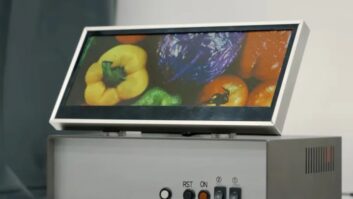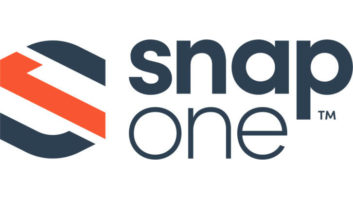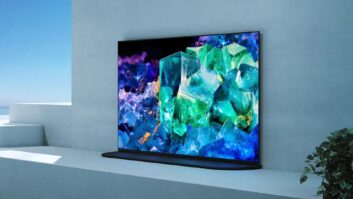Tweeter is beginning to sound more like a Woofer.
It was a scant three years ago that the regional specialty chain set out from Boston to conquer a continent. It’s armaments: a mix of high-end A/V gear, a customer-comes-first philosophy, and a war chest fueled by public and private funds.
Now, four acquisitions later, the Tweeter flag is flying coast to coast, and Tweeter Home Entertainment Group – the corporate entity born of Tweeter etc. – plans to redouble its efforts by doubling its size in the next four years.
How will it continue its expansion? How is it handling its current conquests? And, perhaps most important, is there a place in the over-stored retail landscape for a national niche player? TWICE put those questions to Tweeter founder, chairman and CEO Samuel “Sandy” Bloomberg , an audio buff and child of the ’60s, who recounted the store’s past and shared his vision for its future.
Bloomberg launched Tweeter etc. with his cousin in 1972 following a stint at AudioLab, a stereo store on Harvard Square. “It was a cool, hip place to work in 1969 for a person who hated college, loved the gear and had a passion for music,” he recalled.
Over the next two decades, that enthusiasm, coupled with private investments by Staples co-founder Leo Kahn and the Bronfman family of Seagram fame, helped turn Tweeter into a regional powerhouse. By 1990, Bloomberg had come up against his own operational limitations and, with an eye toward national expansion, recruited Scandinavian Design head Jeffrey Stone to be the company’s president.
“I’m the founder, the entrepreneur. I handle the vision side and the merchandising,” Bloomberg explained. “Jeff has the management skills and the operating skills, and knows all about running upscale, specialty niche stores.”
Soon, the pair had fomented an acquisition strategy that would take Tweeter to the national level and successfully pitched it to their biggest backer.
“We decided that we wanted a new challenge, to pave new territory, and we sold the Bronfmans on the idea of consolidating similar, family-run businesses in order to achieve scale and efficiencies,” Bloomberg said. “We foresaw the emergence of the national electronics chains. We knew that Circuit and Best Buy would be big, and we also saw a place for a national specialty retailer.”
At the same time, Tweeter would provide an exit strategy for small, family-owned operations that lacked a succession plan or investment capital. Moreover, Bloomberg could appreciate the mixed emotions that come with selling a business that was started from scratch.
“We assure them that we’ll treat their people well, maintain the integrity of their brand, and that we’re a satisfying place to transfer their company to,” he said.
The first acquisition, Pennsylvania’s 13-unit Bryn Mawr Stereo & Video, came in May 1996 following three years of informal talks with founder and chairman Fred Lokoff.
“Bryn Mawr was easier [than successive buys],” Bloomberg said. “We knew Fred. Bryn Mawr was close to us geographically and philosophically. Like us, it was a nice regional chain that was started in the late ’60s, early ’70s by a bunch of hi-fi enthusiasts who learned how to run a business.”
Tweeter’s strategy suffered a setback in 1995 when the Bronfmans decided they wanted out of the venture capital business, and seed money dried up as scores of CE retailers went under. Coming to the rescue was investment banker Michael Cronin of Western Presidio, a contrarian who looked beyond the shuttered storefronts to the coming digital revolution. “He foresaw the analog-digital conversion and the consumer confusion that the new technologies would create,” said Bloomberg. “He saw an opportunity for a retailer that could provide the sales support that DVD and HDTV would require.”
In quick succession, Tweeter bought HiFi Buys in 1997, refueled its war chest with a successful IPO in 1998, and this year added Home Entertainment of Texas and Dow Stereo/Video.
“Each acquisition had a different twist because each company is very different,” Bloomberg said. “But I think Fred and Joe [Brown of Home Entertainment] are very happy, and feel good about selling their businesses.”
In picking his acquisition targets, Bloomberg considers four criteria: brand name, physical assets, market demographics and, most important, sales people. Tweeter grades each on a scale of one to 10, using focus groups to determine the brand’s perception within its market. Also considered are the market’s growth potential and the number of stores that would be kept or closed in the event of a buy.
So far, the formula has yielded few surprises, allowing Tweeter to turn its attention to consolidating its holdings and leveraging the Tweeter franchise. Already, all four acquisitions have been integrated into the company’s back-office systems, and all buying is conducted from corporate headquarters in Canton, Mass.
Eventually, all stores – with the exception of unauthorized regions – will carry Tweeter’s core brands, although the mix will be continuously fine-tuned to accommodate local markets, said Bernie Sapienza, merchandising and purchasing VP.
One of the biggest challenges of integrating Tweeter’s far-flung operations has been the wide variance in store size. “It’s easy to have the same box, but we’ve acquired stores that range from 1,500 to 30,000 square feet,” Bloomberg said. On average, Tweeter etc. stores are 10,000 to 12,000 square feet.
The problem is particularly acute in Texas. “We’re challenged in TV and car stereo there because of the physical space limitations of the Home Entertainment stores,” noted Sapienza. However, six new or relocated units are planned for next year that will allow for a more uniform product mix by the fourth quarter of 2000, Bloomberg said.
The company is also beginning to speak with one voice via uniform signage and in-store displays, a consistent advertising message chainwide and the addition of the corporate designation “A Tweeter Company” to the logo of each store group.
“We’re starting to talk about all of our affiliates being a part of a Tweeter company,” said Noah Herschman, VP of marketing. “We’re leveraging our name in national advertising, and with the exception of some minor regional tweaking, all of the advertising is the same.”
Within the next three to six months, Tweeter will also be bringing its in-house training program to all of its chains. The program, which the company considers a key asset, provides five weeks of intensive classroom training for new sales associates and five to 15 days of ongoing training throughout the year.
All this begs the question of whether all stores will ultimately go by the Tweeter name. That, said Herschman, is “to be determined.”
While Tweeter’s regional outposts begin to fall in line behind a central vision, headquarters is learning to change as well. “The whole is greater than the sum of its parts,” Herschman said. “This is not Tweeter saying `This is how we do things.’ We also want to learn what they do better than us.”
Indeed, the home office has already gleaned a thing or two about expense controls from Bryn Mawr, sales volume from HiFi, custom home installation from Home Entertainment, and event marketing from Dow, according to Bloomberg.
Is Tweeter’s acquisition strategy actually working? So far, the company’s best-laid plans are yielding steadily improving results. While same-store sales were only up 1.1% for the fiscal third quarter that ended June 30 – dragged down by negative comps at HiFi – the company was going up against a 25% comp store increase for the year-ago period, explained president Stone. More important, profits at HiFi were above expectations, while companywide margins were strong enough to project third-quarter earnings of $800,000, compared to a $588,000 loss for the same period a year ago.
“Our focus is not top line, it’s bottom line,” stressed Bloomberg. “Volume without earnings is a waste of time.” In the case of HiFi, which competed in the entry-level category, a falloff in volume was anticipated.
“We said we’d pull back the business and abandon the entry-level merchandise in order to not compete with Best Buy. Instead, we’re moving it to our higher-margin, lower-turns model,” he said.
The strategy is already proving itself elsewhere in the system. Bryn Mawr, for example, which was a $27 million operation when it was bought in 1996, is expected to hit the $80 million mark in fiscal 2000. Similarly, Bloomberg anticipates Home Entertainment, whose comp store sales were up 5.1% for the quarter, will quadruple its revenues to $100 million over the next three to four years.
So what’s up next for Tweeter? To meet his goal of doubling the business by 2003, Bloomberg will build out existing markets at a 20% clip while sticking to his growth-through-acquisition plan. “We can ultimately double our stores out of existing regions without any acquisitions and without stepping on PRO’s toes,” he said, referring to the Progressive Retailers Organization, of which Tweeter is a member. “We have no interest in competing geographically with fellow PRO members.”
Short term, Tweeter will open or relocate 20 to 25 stores within the next 15 months, with most of the expansion slated for Texas and the Atlanta region. “The migration to those areas is staggering,” Bloomberg said, while the original Tweeter etc. markets are “close to maximized.” Further down the road, the company will set its sights on California, where management envisions a 30- to 40-store presence stretching from Los Angeles to San Diego.
At the same time, Tweeter continues to seek out strong regional specialty chains that are ripe for acquisition. “There are still opportunities out there,” Bloomberg said. “It’s a matter of finding owners with no family to pass the business on to and a limited exit strategy.”
Also in the works is an Internet selling site, [email protected], which will be launched this fall in partnership with e-commerce pioneer Cyberian Outpost (see related story). While Bloomberg doesn’t expect it to become a significant part of the business, he said the site will provide a service to time-stressed Tweeter customers and folks who’ve built their dream homes in remote or rural areas.
And what of Circuit City and Best Buy? Can Tweeter withstand the big box juggernauts outside the safety of its New England base? “They’re very competent and formidable and sell lots of broad-based CE products to a wide market,” Bloomberg said. “But we’re highly differentiated from that. We’re the classic specialty retailer that offers a high level of service and highly knowledgeable sales associates.”
For Bloomberg, the difference really hit home one afternoon while he was checking out the big box competition. “There was a Mercedes parked in front of the store and they were loading a big Sony TV. And I thought, `If that was one of our stores, they’d be loading a big TV and a surround sound system.'”













